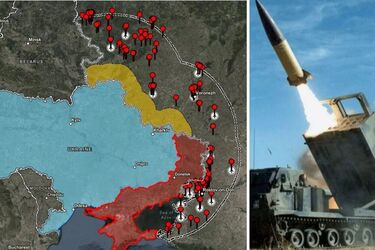Ukraine has launched a new stage of strikes against Russia: what's in the crosshairs?

Since the information appeared in the Western media that Ukraine had received permission to launch strikes with long-range missiles on Russian territory, we have seen at least three that fit neatly into the concept of hitting military facilities and related infrastructure.
And despite the fact that the strike zone is limited to 300 kilometers from the border with Ukraine, this is enough to focus on the targets there - which are more than 200 stationary military facilities of varying degrees of importance.
More about it - in the material of the joint project of OBOZ.UA and the group "Information Resistance".
Before paying attention to the strikes on Russia with new means of destruction, which so far include ATACMS and Storm Shadow, I would like to remind you what the Ukrainian Defense Forces were mainly hitting Russian facilities with.
The main means of defeat were attack drones, which, depending on their modifications, traveled from hundreds to thousands of kilometers.
One of the most notable in the first wave was a strike on the Russian airfield "Engels" on December 5, 2022, during which one Tu-95MS was destroyed and damaged. At the same time, a Tu-22M3 was seriously damaged at the Dyagilevo airfield.
Ukraine systematically used attack drones on Russian territory, improving their characteristics and expanding the range of targets. But the systematic strikes on military facilities, airbases, ammunition depots, and, over time, on the Russian oil refining industry remained unchanged.
Strikes on refineries
The main wave of strikes on Russian oil refineries began on the night of January 18, 2024, when for the first time Ukrainian attack drones reached the Leningrad region (having traveled 900 km) and struck the St. Petersburg oil terminal.
By the end of January 2024, there were also strikes on the refineries in Klintsy in the Bryansk region, Ust-Luga in the Leningrad region, Tuapse in the Krasnodar region, Yaroslavl, Kstovo in the Nizhny Novgorod region, etc.
The strikes on oil refineries affected both the economy of the aggressor country and the supply of fuel and lubricants to the Russian occupation troops. Exports of oil products decreased, which caused a reduction in revenues to the Russian budget and a shortage of relevant products for the troops.
Description:
A fire at an oil depot in Proletarsk, Rostov Region, Russian Federation.
Source:
Planet Labs
Alt:
Nevertheless, the Ukrainian Defense Forces did not focus exclusively on strikes against the refinery and alternated (and sometimes combined) strikes against different targets. This forced the ROE to spread their attention between them in an attempt to defend against the strikes and to determine which ones the Ukrainian side might prioritize for destruction.
Therefore, throughout 2024, we equally heard not only about attacks on refineries and oil storage facilities, but also on arsenals with ammunition, factories and enterprises of the military-industrial complex, unique radars, (e.g., such as Voronezh-DM), and even the Caspian Flotilla, which came under attack by a drone of the Ukrainian Defense Ministry's GUR.
But the constant problem with attack drones was that most of them carried insufficiently powerful warheads, averaging 40-70 kilograms, and could not strike over an area. Of course, this situation has changed with Ukraine's authorization to use ATACMS and Storm Shadow.
New Wave Strikes
On the night of November 19, the Ukrainian Defense Forces struck the 1046th logistics center of the Russian Armed Forces near the town of Karachev in Bryansk Oblast. ATACMS ballistic missile was used in the strike.
Two days later, on November 21, the command post near Maryino, Kursk Region, was struck, but already using British subsonic Storm Shadow cruise missiles in an amount of at least 10 units. The results of the strike still give rise to all sorts of theories, up to the point that up to 500 North Korean military personnel were killed at the site. In any case, the attack had a sufficient effect, as the command center of the Kursk grouping of RWOs was completely destroyed.
On the night of November 25, the Khalino airfield, which is located in Kursk Region (100 km from the border with Ukraine), was struck. It was not only actively used for launching strike and reconnaissance UAVs, but also for tactical aviation and attack helicopters. In addition, the construction of reinforced concrete shelters for Russian tactical aviation has been accelerated at this airfield in recent months.
During the strike on the Kursk region, an S-400 SAM system was also destroyed.
In fact, a new stage of strikes on Russian territory is beginning, through not only standard strike drone raids, but also long-range missiles that can act both independently and in combination.
And despite the fact that the strike zone is limited to 300 kilometers from the border with Ukraine, it is enough to focus on the facilities there. After all, more than 200 stationary military facilities of varying degrees of importance - arsenals, control centers, headquarters, fuel and lubricant depots and others - are located in this zone. In the same zone there are 16 military airfields, which are actively used by the Russian occupation troops.
It is also noteworthy that now the Ukrainian Defense Forces have variability in the use of means of defeat. For example, strikes on exclusively military facilities, such as arsenals and command posts, military units and so on, can be provided by ATACMS and Storm Shadow. In turn, systemic raids on refineries and oil storage facilities can be reinforced by the drone component, which should not be objectionable to our partners.
On the night of November 25, that is exactly what happened. While ATACMS flew to Khalino, in Kaluga drones hit a tank complex of oil products, which, by the way, was not far from the instrument-making plant "Typhoon", which produces coastal missile systems and other products for the needs of the Russian Navy.
But the most important thing is that Ukraine has not yet received from its partners all types of missiles with which it can hit the territory of Russia, and what we can expect from our allies, I told in the previous material.
Conclusions
The authorization to strike Russian territory with long-range missile weapons allows Ukraine to more rationally and comprehensively use both its own resources and means of defeat from its partners.
By distributing targets among themselves and concentrating on certain objects, the Ukrainian Defense Forces will be able to achieve a much greater effect in terms of undermining the logistics of the RWM, as well as the command and control system at one level or another.
Given the number of important facilities in the 300-kilometer zone, there is a lot of work there. At least until the appearance of a Ukrainian long-range cruise missile in the near zone, there will be something to do, plunging it into the Paleolithic period

